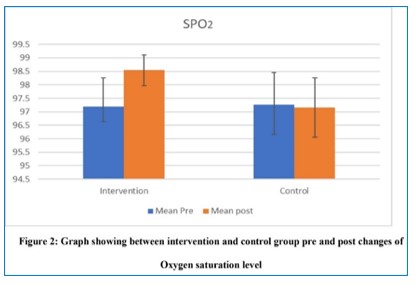Physiological effect of Bhastrika Pranayama on Cardio-Pulmonary variables among healthy individuals - A Randomized Controlled Trial
DOI:
https://doi.org/10.21760/jaims.8.12.5Keywords:
Bhastrika Pranayama, Blood pressure, Heart rate, Peak expiratory flow rate, Respiratory rate, SpO2Abstract
Background And Objectives: Bhastrika Pranayama boosts airflow into the body, which produces heat both physically and subtly, igniting both the body's and mind's internal fires. This fast-breathing Pranayama increases energy, cleanses and regenerates the lungs, tones the diaphragm, heart, and abdominal muscles, improves circulation. Hence, the objective of this study was to assess the physiological impact of Bhastrika Pranayama on healthy individuals using cardio-pulmonary variables. Materials and Methods: 110 healthy male and female participants between the ages of 18 and 25 were enrolled, and they were randomly divided into a control group and a Pranayama group. The parameters SpO2, SBP, DBP, HR, RR, and PEFR were noted for pre and post values for both groups were recorded. The parameters were measured using a peak flow metre, cardiac monitor, and pulse oximeter. The Pranayama group received Bhastrika Pranayama for 4 weeks whereas the control group received no intervention. Result: The Pranayama group showed a significant improvement in SpO2 (p≤0.05), RR (p≤0.05) and PEFR (p≤0.05) and a small reduction in SBP, DBP and HR. Whereas, no significant changes were observed in the control group. Discussion: Following 4-week of Bhastrika Pranayama shows improvement in PEFR, RR, and SpO2 while lowers HR, SBP, and DBP somewhat. The benefits of Bhastrika Pranayama in healthy people in terms of fitness-related health conditions, both in the short and long term, may also be revealed by future research.
Downloads
References
Swami Sathyananda Saraswati. Asana Pranayama Mudra Bandha. 3rd edition. Bihar: Yoga Publications Trust; 2004; p. 1-409.
Iyengar BKS. The Tree of Yoga. HarperCollins Publishers, India, 1995; p. 5.
Woodyard C. Exploring the therapeutic effects of Yoga and its ability to increase quality of life. Int J Yoga. 2011 Jul;4(2):49-54.
BKS Iyengar. Light on Pranayama. HarperCollins Publisher Ltd; 2014; p. 7, 16-18.
Veerabhadrappa SG, Herur A, Patil S, Ankad RB, Chinagudi S, Baljoshi VS, et al. Effect of yogic bellows on cardiovascular autonomic reactivity. J Cardiovasc Dis Res. 2011 Oct 1;2(4):223-7.
Parshad O. Role of Yoga in stress management. West Indian Med J. 2004 Jun 1;53(3):191-4.
Telles S, Joseph C, Venkatesh S, Desiraju T. Alterations of auditory middle latency evoked potentials during yogic consciously regulated breathing and attentive state of mind. Int J Psychophysiol. 1993 May 1;14(3):189-98.
Swami Muktibodhananda. Hath Yoga Pridipika. 4th edition. Bihar: Yoga Publication Trust; 2010; p. 232.
Mower WR, Sachs C, Nicklin EL, Safa P, Baraff LJ. A comparison of pulse oximetry and respiratory rate in patient screening. Respir Med. 1996 Nov 1;90(10):593-9.
Philips - Efficia CM Patient Monitor Efficia CM 10 Patient Monitor [Internet]. Philips. [cited 2023 Dec 21].
Manjunath CB, Kotinatot SC, Babu M. Peak expiratory flow rate in healthy rural school-going children (5-16 years) of Bellur region for construction of nomogram. J Clin Diagn Res. 2013 Dec;7(12):2844.
Pramanik T, Sharma HO, Mishra S, Mishra A, Prajapati R, Singh S. Immediate effect of slow pace Bhastrika Pranayama on blood pressure and heart rate. J Altern Complement Med. 2009 Mar 1;15(3):293-5.
Chail R, Anjusha IB. Effect of the short-term practice of Pranayama on the autonomic functions in 1st-year MBBS students. Natl J Physiol Pharm Pharmacol. 2019 Jan 2;9(2):150-4.
Jain PK, Malhotra V, Goel N, Gupta S. Effects of 40 days of Pranayama training in hypertensive subjects. Int J Physiol. 2019 Apr;7(2):45-9.
Jerath R, Edry JW, Barnes VA, Jerath V. Physiology of long pranayamic breathing: neural respiratory elements may provide a mechanism that explains how slow deep breathing shifts the autonomic nervous system. Med Hypotheses. 2006 Jan 1;67(3):566-71.
Mubarak G, Rajasekhar P, Vastard BC, Nise US. Effect of Sukha Pranayama and Bhastrika Pranayama on cardiovascular autonomic functions among young healthy individuals. J. Evid Based Med Healthc. 2016; 3(40), 1968-71.
Garg S, Chandla SS. Comparative effect of fast and slow breathing Pranayama on pulmonary functions in students. Int J Health Sci Res. 2017; 7(10):82-6.
Arulmozhi S, Joice SP, Maruthy KN. Effect of Pranayama on respiratory muscle strength in chronic asthmatics. Natl J Physiol Pharm Pharmacol. 2018; 8(12):1700-3.
Ankad Roopa B, Ankad Balachandra S, Herur Anita PS, Chinagudi Surekharani GV. Effect of short-term Pranayama and meditation on respiratory parameters in healthy individuals. Int. J. Collab Res Intern Med Public Health. 2011 Jun;3(6):430-7.
Priyanka Singh, Asha Gandhi, Naveen Gaur. A study of cardio-respiratory changes in sedentary medical students after 12 weeks of Pranayama and meditation practices. J Cardiovasc Dis Res. 2021;12(6):1770-77.
Pathak R, Goel S, Yadav N, Srivastav R. A comparative study of effects of Pranayama and aerobic exercise on spirometric indices in the age group of 30–50 years. Natl J Physiol Pharm Pharmacol. 2023;13(4):740-3.
Mayuri Patil, Leena Chaudhary, Rajesh Patil. Impact of Pranayama’s on Pulmonary Function Test: A comparative Study.2023;2(12):3446-60.
Gokhale V, Lakshmeesha DR, Shetty V, Rani V, Naresh Kumar M. Influence of Kapalabhati Pranayama on oxygen saturation and blood pressure. Int J Med Health Res. 2018;4(9):113-7.
Taru RS, Kaluskar R. The Immediate Effect of Yogasana On Oxygen Saturation Levels in Young Adults. TMV’s Knowledge Resource centre Digital Repository.2022;1(1):1-9.















